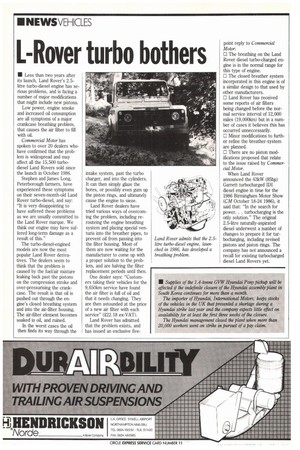1-Rover turbo bothers
Page 16

If you've noticed an error in this article please click here to report it so we can fix it.
MI Less than two years after its launch, Land Rover's 2.5litre turbo-diesel engine has serious problems, and is facing a number of major modifications that might include new pistons.
Low power, engine smoke and increased oil consumption are all symptoms of a major crankcase breathing problem, that causes the air filter to fill with oil.
Commercial Motor has spoken to over 20 dealers who. have confirmed that the problem is widespread and may affect all the 15,500 turbodiesel Land Rovers sold since the launch in October 1986.
Stephen and James Long, Peterborough farmers, have experienced these symptoms on their seven-month-old Land Rover turbo-diesel, and say: "It is very disappointing to have suffered these problems as we are usually committed to the Land Rover marque. We think our engine may have suffered long-term damage as a result of this."
The turbo-diesel-engined models are now the most popular Land Rover derivatives. The dealers seem to think that the problem is caused by the fuel/air mixture leaking back past the pistons on the compression stroke and over-pressurising the crankcase. The result is that oil is pushed out through the engine's closed breathing system and into the air-filter housing. The air-filter element becomes soaked in oil, and ruined.
In the worst cases the oil then finds its way through the intake system, past the turbo charger, and into the cylinders. It can then simply glaze the bores, or possibly even gum up the piston rings, and ultimately cause the engine to sieze.
Land Rover dealers have tried various ways of overcoming the problem, including rerouteing the engine breathing system and placing special venturis into the breather pipes, to prevent oil from passing into the filter housing. Most of them are now waiting for the manufacturer to come up with a proper solution to the problem, and are halving the filter replacement periods until then.
One dealer says: "Customers taking their vehicles for the 9,650km service have found the air filter is full of oil and that it needs changing. They are then astounded at the price of a new air filter with each service" (222.18 ex-VAT).
Land Rover has admitted that the problem exists, and has issued an exclusive five point reply to Commercial Motor o The breathing on the Land Rover diesel turbo-charged engine is in the normal range for this type of engine.
El The closed breather system incorporated in this engine is of a similar design to that used by other manufacturers.
o Land Rover has received some reports of air filters being changed before the normal service interval of 12,000 miles (19,000krn) but in a number of cases it believes this has occurred tumeccessarily.
I: Minor modifications to further refine the breather system are planned.
There are no piston modifications proposed that relate to the issue raised by Commercial Motor.
When Land Rover announced the 63kW (85hp) Garrett turbocharged ILK diesel engine in time for the 1986 Birmingham Motor Show (CM October 18-24 1986), it said that: "In the search for power.. . turhochartrig is the only solution." The original 2.5-litre naturally-aspirated diesel underwent a number of changes to prepare it for turbocharging, including revised pistons and piston rings. The company has not announced a recall for existing turbocharged diesel Land Rovers yet.
















































































































